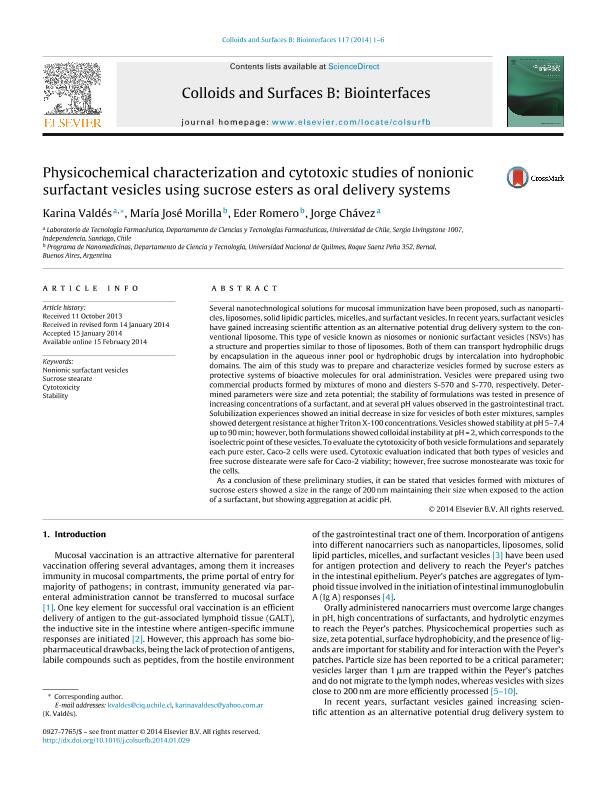Mostrar el registro sencillo del ítem
dc.contributor.author
Valdés, Karina
dc.contributor.author
Morilla, María José

dc.contributor.author
Romero, Eder Lilia

dc.contributor.author
Chávez, Jorge
dc.date.available
2018-01-10T17:13:20Z
dc.date.issued
2014-02
dc.identifier.citation
Chávez, Jorge; Romero, Eder Lilia; Morilla, María José; Valdés, Karina; Physicochemical characterization and cytotoxic studies of nonionic surfactant vesicles using sucrose esters as oral delivery systems; Elsevier; Colloids and Surfaces B: Biointerfaces; 117; 2-2014; 1-6
dc.identifier.issn
0927-7765
dc.identifier.uri
http://hdl.handle.net/11336/32819
dc.description.abstract
Several nanotechnological solutions for mucosal immunization have been proposed, such as nanoparticles, liposomes, solid lipidic particles, micelles, and surfactant vesicles. In recent years, surfactant vesicles have gained increasing scientific attention as an alternative potential drug delivery system to the conventional liposome. This type of vesicle known as niosomes or nonionic surfactant vesicles (NSVs) has a structure and properties similar to those of liposomes. Both of them can transport hydrophilic drugs by encapsulation in the aqueous inner pool or hydrophobic drugs by intercalation into hydrophobic domains. The aim of this study was to prepare and characterize vesicles formed by sucrose esters as protective systems of bioactive molecules for oral administration. Vesicles were prepared using two commercial products formed by mixtures of mono and diesters S-570 and S-770, respectively. Determined parameters were size and zeta potential; the stability of formulations was tested in presence of increasing concentrations of a surfactant, and at several pH values observed in the gastrointestinal tract. Solubilization experiences showed an initial decrease in size for vesicles of both ester mixtures, samples showed detergent resistance at higher Triton X-100 concentrations. Vesicles showed stability at pH 5–7.4 up to 90 min; however, both formulations showed colloidal instability at pH = 2, which corresponds to the isoelectric point of these vesicles. To evaluate the cytotoxicity of both vesicle formulations and separately each pure ester, Caco-2 cells were used. Cytotoxic evaluation indicated that both types of vesicles and free sucrose distearate were safe for Caco-2 viability; however, free sucrose monostearate was toxic for the cells. As a conclusion of these preliminary studies, it can be stated that vesicles formed with mixtures of sucrose esters showed a size in the range of 200 nm maintaining their size when exposed to the action of a surfactant, but showing aggregation at acidic pH.
dc.format
application/pdf
dc.language.iso
eng
dc.publisher
Elsevier

dc.rights
info:eu-repo/semantics/openAccess
dc.rights.uri
https://creativecommons.org/licenses/by-nc-sa/2.5/ar/
dc.subject
Nonionic Surfactant Vesicles
dc.subject
Sucrose Stearate
dc.subject
Cytotoxicity
dc.subject
Stability
dc.subject.classification
Nano-materiales

dc.subject.classification
Nanotecnología

dc.subject.classification
INGENIERÍAS Y TECNOLOGÍAS

dc.title
Physicochemical characterization and cytotoxic studies of nonionic surfactant vesicles using sucrose esters as oral delivery systems
dc.type
info:eu-repo/semantics/article
dc.type
info:ar-repo/semantics/artículo
dc.type
info:eu-repo/semantics/publishedVersion
dc.date.updated
2018-01-08T19:49:51Z
dc.journal.volume
117
dc.journal.pagination
1-6
dc.journal.pais
Países Bajos

dc.journal.ciudad
Ámsterdam
dc.description.fil
Fil: Valdés, Karina. Universidad de Chile; Chile
dc.description.fil
Fil: Morilla, María José. Universidad Nacional de Quilmes. Departamento de Ciencia y Tecnología; Argentina. Consejo Nacional de Investigaciones Científicas y Técnicas; Argentina
dc.description.fil
Fil: Romero, Eder Lilia. Universidad Nacional de Quilmes. Departamento de Ciencia y Tecnología; Argentina. Consejo Nacional de Investigaciones Científicas y Técnicas; Argentina
dc.description.fil
Fil: Chávez, Jorge. Universidad de Chile; Chile
dc.journal.title
Colloids and Surfaces B: Biointerfaces

dc.relation.alternativeid
info:eu-repo/semantics/altIdentifier/url/http://www.sciencedirect.com/science/article/pii/S0927776514000307
dc.relation.alternativeid
info:eu-repo/semantics/altIdentifier/doi/http://dx.doi.org/10.1016/j.colsurfb.2014.01.029
Archivos asociados
